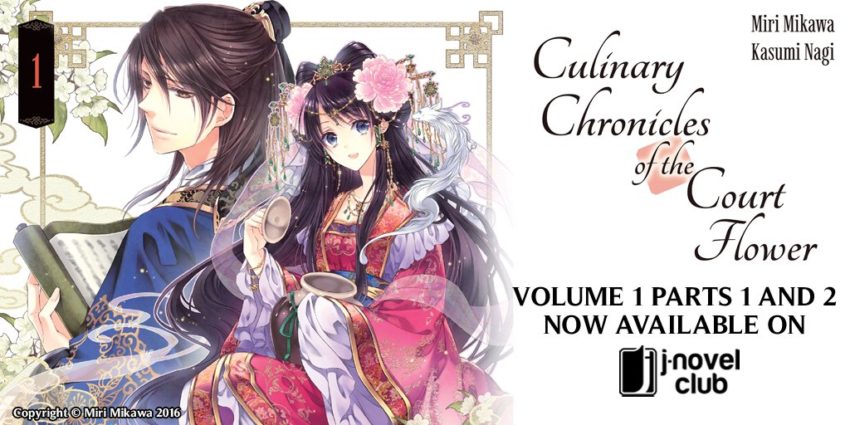Books: Culinary Chronicles of the Court Flower
December 18, 2021 · 0 comments
By Jeannette Ng.

It’s hard not to compare Culinary Adventures of the Court Flower by Miri Mikawa with The Apothecary Diaries, as both are heavily inspired by imperial China and more specifically set within an imperial harem. But the two don’t simply have very different heroines; the approach to the translation and the frame are different. Culinary Adventures‘s Setsu Rimi (also known as Ayako the Umashi-no-Miya) is foreign to the setting of the court. She is an expendable princess from “Wakoku” (Japan) who was brought up solely dedicated to the art of food, and struggles with the language and culture of “Konkoku”. She wants nothing more cook the food of her homeland and keep her beloved pickling bed, but circumstances at court are conspiring against her as her various eccentricities mark her out as a target.
Food is central to Culinary Adventures with the sense of taste itself being a shorthand to a character’s emotional state. When first entering the rear palace, Rimi loses her sense of taste and it is only through slowly eating food from her own culture that she was able to revive it. Thus when she learns the Emperor himself struggles to taste food, she wonders what trauma could have caused this. Shu Shusei, an absent-minded scholar, in particular seems to take a deep interest in Rimi’s approach to food as she finds herself defending the tribute of ingredients that Wakoku has sent. The dried seaweed and blocks of dried fish (umifu and kengyoken) are worth their weight in gold, but the Konkoku courtiers mistake it for trash and Rimi must prove to them that food worthy of the emperor can be made from them.
The detail when it comes to food is meticulous and absolutely delicious, but beyond that Culinary Adventures offers long, quasi-philosophical quasi-metaphysical conversations about food. Though which terms do and don’t get preserved when it comes to ingredients and dishes are a mild source of frustration for me, as we have “fish stock” instead of dashi but ganjiang, a dry yellow soybean paste, gets to remain untranslated. Despite appearing not as the familiar filled dumpling but simply sheets of boiled dough that become cloud-like suspended in soup, wonton is still rendered as the anglicised “wonton” when the Mandarin huntun might have avoided some confusion. At other times, I find myself wondering if something were a loanword from real world Japanese cooking or if it is invented by the author as part of their worldbuilding. Blending the real and the fantastical is at the heart of verisimilitude but here it is sometimes distracting and I would have preferred a translator’s note for clarity.
Given the various recent internet feuds over which of the East Asian cultures kimchi “really” belongs to, there’s something in me that very much wanted a light novel series that has a girl from the Japanese islands prove those snooty mainland imperials wrong with her own culture’s cooking techniques. One can’t really fight one nationalism with nationalism, but given how much of Chinese history and current propaganda is about how it is the source all high culture, this can feel like an palate cleanser, even if it is no antidote.
Jeannette Ng is the author of Under the Pendulum Sun. Culinary Chronicles of the Court Flower is published by J-Novel Club.
Leave a Reply